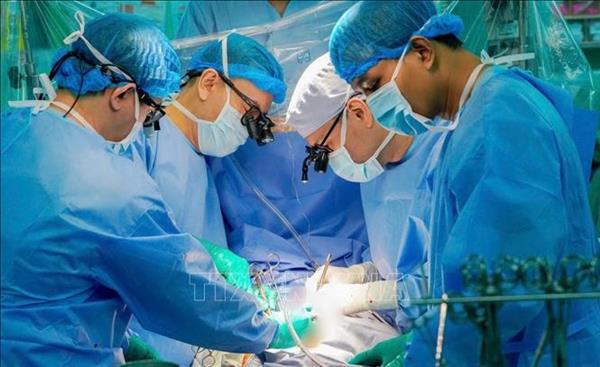Hanoi, March 21 (VNA) – The Ministry of Industry and Trade (MoIT) will continue pursuing the dream of a real auto industry in Vietnam despite the failure of 20 years of efforts towards this goal.
The ministry has set the target to increase the local content of cars to 80 percent and turn car production into an important industry in 2025-2035.
Director of the MoIT’s Heavy Industry Department Truong Thanh Hoai said Vietnam’s auto industry has a capacity of producing and assembling around 500,000 cars each year at present, meeting 70 percent of the domestic car demand. A supporting industry for this sector is taking shape, providing several kinds of car parts such as mirrors, glass, seats, electric wire, battery, tyres, and plastic details.
At the same time, he admitted that the industry failed to meet the set targets. After 20 years, the local content of cars is just about 7 – 10 percent at present while the original targets were 40 percent by 2005 and 60 percent by 2010.
Domestically made cars have lower quality and higher prices compared to imported ones, with production stopping at simple level focusing on welding, painting, assembling, and inspection.
The MoIT partly attributed the failure to instable policies on taxation, fees and infrastructure for the sector, a lack of consensus among state management agencies, and a shortage of concrete action plans and manpower and financial resources for policy implementation.
Moreover, many foreign carmakers do not want to expand operations in Vietnam since they already invested in big auto production projects in regional countries like Thailand and Indonesia. Buyers’ preference for imported cars with advanced functions and better design has also affected the stake of Vietnamese automobiles, according to the ministry.
The MoIT said with a population of almost 100 million and growing per capita GDP and middle class, Vietnam has an expanding car market which posted an average growth rate of nearly 40 percent in the last two years.
Many experts also believed in the potential of the domestic market, which no carmakers should miss.
To realise the target for 2025-2035, MoIT Deputy Minister Do Thang Hai said the local auto industry will strive to take part in the global production chains of existing manufacturers. He said assistance will be given to businesses with large production volume, and attention will be paid to attracting investment from firms which have yet to run any big production lines in ASEAN.
The ministry will also encourage the purchase of made-in-Vietnam cars and take suitable measures to ensure fair competition between domestically-made and import automobiles.
However, there is doubt about the MoIT’s ambition especially when Vietnam will have to cut the import tariff on completely built units (CBUs) from ASEAN to zero percent on January 1, 2018 in line with commitments in the ASEAN Free Trade Area (AFTA).
Nguyen Tuan from the Thien Phuc An Co. Ltd pointed out that Vietnam’s auto industry failed to “grow up” despite many protection measures and incentives over the last 20 years. He said when the CBU import tax reduces to zero percent, domestically produced cars will not be able to compete with imported autos and the inevitable trend will be increasing the import of CBUs.
Big manufacturers like Toyota and Honda have been gradually reducing production activities in Vietnam and instead import cars like Fortuner and Civic to distribute in the domestic market.
Other assembling joint ventures are also facing the same issue.
Toru Kinoshita, President of Toyota Vietnam and Chairman of the Vietnam Automobile Manufacturers’ Association (VAMA), said when the tariff cut takes effect, some VAMA members may be unable to compete with imports and thus may cease to exist.
Therefore, State management agencies should provide more support to the car sector, e said.
The ministry has set the target to increase the local content of cars to 80 percent and turn car production into an important industry in 2025-2035.
Director of the MoIT’s Heavy Industry Department Truong Thanh Hoai said Vietnam’s auto industry has a capacity of producing and assembling around 500,000 cars each year at present, meeting 70 percent of the domestic car demand. A supporting industry for this sector is taking shape, providing several kinds of car parts such as mirrors, glass, seats, electric wire, battery, tyres, and plastic details.
At the same time, he admitted that the industry failed to meet the set targets. After 20 years, the local content of cars is just about 7 – 10 percent at present while the original targets were 40 percent by 2005 and 60 percent by 2010.
Domestically made cars have lower quality and higher prices compared to imported ones, with production stopping at simple level focusing on welding, painting, assembling, and inspection.
The MoIT partly attributed the failure to instable policies on taxation, fees and infrastructure for the sector, a lack of consensus among state management agencies, and a shortage of concrete action plans and manpower and financial resources for policy implementation.
Moreover, many foreign carmakers do not want to expand operations in Vietnam since they already invested in big auto production projects in regional countries like Thailand and Indonesia. Buyers’ preference for imported cars with advanced functions and better design has also affected the stake of Vietnamese automobiles, according to the ministry.
The MoIT said with a population of almost 100 million and growing per capita GDP and middle class, Vietnam has an expanding car market which posted an average growth rate of nearly 40 percent in the last two years.
Many experts also believed in the potential of the domestic market, which no carmakers should miss.
To realise the target for 2025-2035, MoIT Deputy Minister Do Thang Hai said the local auto industry will strive to take part in the global production chains of existing manufacturers. He said assistance will be given to businesses with large production volume, and attention will be paid to attracting investment from firms which have yet to run any big production lines in ASEAN.
The ministry will also encourage the purchase of made-in-Vietnam cars and take suitable measures to ensure fair competition between domestically-made and import automobiles.
However, there is doubt about the MoIT’s ambition especially when Vietnam will have to cut the import tariff on completely built units (CBUs) from ASEAN to zero percent on January 1, 2018 in line with commitments in the ASEAN Free Trade Area (AFTA).
Nguyen Tuan from the Thien Phuc An Co. Ltd pointed out that Vietnam’s auto industry failed to “grow up” despite many protection measures and incentives over the last 20 years. He said when the CBU import tax reduces to zero percent, domestically produced cars will not be able to compete with imported autos and the inevitable trend will be increasing the import of CBUs.
Big manufacturers like Toyota and Honda have been gradually reducing production activities in Vietnam and instead import cars like Fortuner and Civic to distribute in the domestic market.
Other assembling joint ventures are also facing the same issue.
Toru Kinoshita, President of Toyota Vietnam and Chairman of the Vietnam Automobile Manufacturers’ Association (VAMA), said when the tariff cut takes effect, some VAMA members may be unable to compete with imports and thus may cease to exist.
Therefore, State management agencies should provide more support to the car sector, e said.
VNA/VNP

















